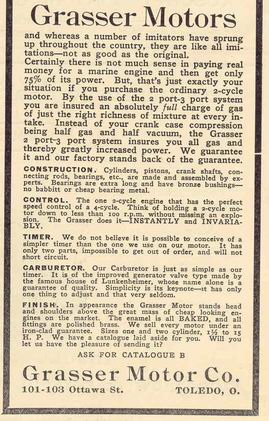|
| Author |
Message |
    
richarddurgee
| | Posted on Wednesday, March 03, 2004 - 09:39 pm: | 




|
Interesting 1909 ad,I split it half to make it large enough to read !

 |
    
Bruce
| | Posted on Thursday, March 04, 2004 - 09:51 pm: | 




|
Richard, looks like Grasser did a bit of a knock off of the Tuttle Timer arrangement |
    
Richard Day
| | Posted on Friday, March 05, 2004 - 07:37 am: | 




|
I have never figured out the real advantage of a 2/3 port over a 2 port. You were still stuck with the check valve speed limatation. The idea that inserting the mixture in the transfer port would give a hotter mixture going into the combustion chamber while perhaps true I wonder if there was any real performance or fuel saving advantage. Two strokes were not noted for fuel savings. |
    
Ernie
| | Posted on Friday, March 05, 2004 - 08:34 am: | 




|
Here are my thoughts on the real 2/3 port and the 2/3 port description that was published in the "One Lung" book a few years back. (3rd edition is still available)
From being around 2 stroke engines since the 50's I have always been familiar with the styles and operation of these engines.
In my book putting the carb/mixer with check valve in the transfer passage does NOT change the style of the engine. It still needs a check valve or in modern terms a reed valve to run. So as far as I am concerned it is still a 2 port engine. In todays terms it would be called a "reed valve" engine. The check valve/reed valve is needed so the mixture that was drawn into the crankcase on the upstroke of the piston doesn't get pushed back out the intake on the down stroke of the piston.
Now the real 2/3 port engine. The engine will have some sort of a check valve in the intake just as any other 2 port engine. In adition it will have a 3rd port that is opened by the piston skirt. in todays terms a "piston port engine" You now have the advantages of both a 2 and a 3 port engine.
These advantages were 2 port better slow speed control and 3 port better high speed performance.
Erd made 2/3 port engines. I have one now. The Gray "T" was a 2/3 port engine. And in all reality the Acadia engines with the extra air inlet valve are 2/3 port engines. The "air valve" was opened and closed by the piston skirt the carb had a check valve.
The more things change the more they stay the same. In the 70's Yamaha came out with "Torque Induction" on some of their 2 stroke bikes. It was a 3 port engine (piston port) and it also had a reed valve (2 port)
Below are 2 pics. One is a Gray "T" advertisement. Look at the intake ports. There are 4 of them. The upper intake ports is uncovered/covered opened/closed by the piston skirt. 3 port
On the up stroke the piston skirt uncovered the port allowing fuel and air intake into the crankcase. On the down stroke the piston skirt covers the intake port preventing the fuel and air mixture from being pushed back out of the crankcase. To run,these engines had the intake seperate from any other port. Making a 3rd port. Hence 3 port.
The lower ports went directly into the crankcase. It had a check valve in that passage it kept the mixture from being pushed back out. 2 port
Look at the 2nd pic. It is a Gray "T" intake manifold. You can clearly see the outer portion of the check valve sticking down out of the bottom.
These are only my own personal thoughts.
Please feel free to comment, or ask questions.

 |
    
richarddurgee
| | Posted on Friday, March 05, 2004 - 10:16 am: | 




|
Great discussion on a cloudy subject!
>
Gray Model"T" 2-3 port illustration.

 |
|
|
|


|


